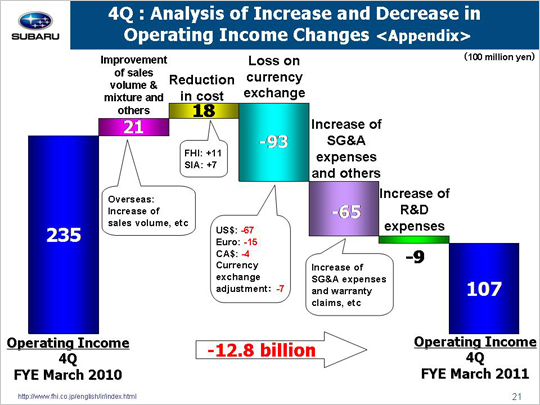
| Now let's look at the factors behind the year on year change in operating income for the three-month fourth quarter period that saw earnings drop from 23.5 billion yen to 10.7 billion yen. The factors that led to the increase in operating income included a gain of 2.1 billion yen due to an improvement in the sales volume and mix. This gain can be broken down into the following three areas. First, we have a loss of 9.7 billion yen from the decreased sales volumes and deteriorated sales mix in the domestic market due to the impact of the earthquake. Next, the sales volumes were up in North America, Russia, Europe and China, where the sales mix also improved due to the launch of the new Legacy. Finally, we have a gain of 10.0 billion yen due to inventory adjustments and others. We gained 1.8 billion yen due to a reduction in material cost, saving 1.1 billion yen at FHI and 0.7 billion yen at SIA. FHI generated a gain of 6.0 billion yen with loss amounting to 4.9 billion yen due to increased material cost. SIA posted a gain of 1.2 billion yen due to a reduction in material cost and a loss of 0.6 billion yen related to rising material prices. Operating income declined 9.3 billion yen due to foreign exchange losses. This included a loss of 6.7 billion yen due to an approximate 7 yen appreciation against the U.S. dollar, a loss of 1.5 billion yen due to an approximate 18 yen appreciation against the euro, and a loss of 0.4 billion yen due to an approximate 3 yen appreciation against the Canadian dollar. A loss of 0.7 billion yen was also posted due to foreign exchange adjustments for transactions between FHI and its overseas subsidiaries. We also saw an increase in SG&A expenses, etc.. that led to a loss of 6.5 billion yen. This amount can be broken down into the following three areas. First, there was a reduction of fixed manufacturing costs that led to a gain of 2.2 billion yen at FHI and flat at SIA. FHI’s decreased fixed processing cost generated a gain of 1.8 billion yen and reduced depreciation of suppliers’ dies resulted in a gain of 0.4 billion yen. SIA lost 0.3 billion yen due to increased processing cost and gained 0.3 billion yen thanks to decrease of depreciation of suppliers’ dies. Next we see that an increase in SG&A expenses produced a loss totaling 6.1 billion yen. FHI generated a loss of 1.1 billion yen while domestic dealers posted a gain of 1.4 billion yen. SOA generated a loss of 1.6 billion yen (17 million dollars). This figure included a loss of 0.4 billion yen (4 million dollars) due to increased advertising expenses and a loss of 1.2 billion yen (13 million dollars) due to increased sales volume despite no significant year-on-year difference in the per-unit incentive, which was 1,200 dollars both for January through March 2010 and the same period in 2011. Our Canadian subsidiary generated a loss of 0.4 billion yen, while our other subsidiaries also saw combined losses totaling 4.4 billion yen. Finally, the third factor includes an increase in costs associated with warranty claims that led to a loss of 2.6 billion yen. An increase in R&D expenses led to a loss of 0.9 billion yen. These factors combined brought operating income down 12.8 billion yen. |